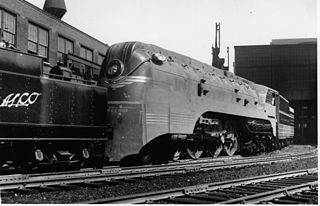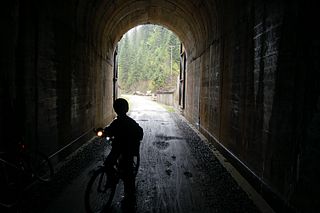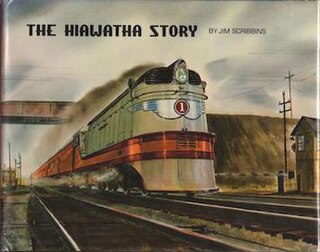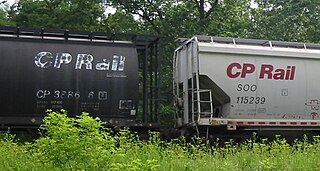
The Hiawathas were a fleet of named passenger trains operated by the Chicago, Milwaukee, St. Paul and Pacific Railroad between Chicago and various destinations in the Midwest and Western United States. The most notable of these trains was the original Twin Cities Hiawatha, which served the Twin Cities in Minnesota. The train was named for the epic poem The Song of Hiawatha by Henry Wadsworth Longfellow.

The North Coast Hiawatha was a streamlined passenger train operated by Amtrak between Chicago, Illinois, and Seattle, Washington, in the United States. It operated from 1971 to 1979. The train was a successor to the Northern Pacific Railway's North Coast Limited and Mainstreeter, although it used the route of the Chicago, Milwaukee, St. Paul and Pacific Railroad east of Minneapolis–Saint Paul. The train's name combined the North Coast Limited with the Milwaukee Road's famed Hiawathas. Created at the behest of the United States Congress, the North Coast Hiawatha enjoyed an uncertain existence before being discontinued in 1979. Since then there have been several attempts to restore the service, without success.

The 400 was a named passenger train operated by the Chicago and North Western Railway between Chicago and Saint Paul, with a final stop in Minneapolis. The train took its name from the schedule of 400 miles between the cities in 400 minutes, and was also a nod to "The Four Hundred Club", a term coined by Ward McAllister to refer to the social elite of New York City in the late 19th century. It was an express train with limited stops between Chicago and the Twin Cities. It ran from 1935 to 1963 and spawned a number of "400" trains.

The Olympian and its successor the Olympian Hiawatha were passenger trains operated by the Chicago, Milwaukee, St. Paul and Pacific Railroad between Chicago and the Pacific Northwest. The Olympian operated from 1911 to 1947 and was, along with its running mate the Columbian, the first all-steel train to operate in the Pacific Northwest. The streamlined Olympian Hiawatha operated from 1947 to 1961 and was one of several Milwaukee Road trains to carry the name "Hiawatha." The Olympian Hiawatha was designed by industrial designer Brooks Stevens and included the distinctive glassed-in "Skytop" observation-sleeping cars. It later featured full-length "Super Dome" cars.

Avery is a small unincorporated community in the northwest United States, nestled in the St. Joe River Valley in Shoshone County, Idaho. Avery is located in the middle of the St. Joe District of the Idaho Panhandle National Forest, and is a popular tourist attraction in northern Idaho for its beautiful wilderness and outdoor recreation. It is upstream and east of St. Maries, the county seat of Benewah County.

The Milwaukee Road's class F7 comprised six (#100–#105) high-speed, streamlined 4-6-4 "Baltic" or "Hudson" type steam locomotives built by Alco in 1937–38 to haul the Milwaukee's Hiawatha express passenger trains. Following on from the success of the road's class A 4-4-2s, the F7s allowed the road to haul heavier trains on the popular Chicago–Twin Cities routes.
The Columbian was a named passenger train operated by the Chicago, Milwaukee, St. Paul and Pacific Railroad between Chicago, Illinois, and Seattle/Tacoma, Washington. The westbound train was Milwaukee Road train #17, and the eastbound train was train #18.

Lookout Pass is a mountain pass in the Rocky Mountains of the northwestern United States. In the Coeur d'Alene Mountains of the Bitterroot Range, the pass is on the border between Idaho and Montana, traversed by Interstate 90 at an elevation of 4,710 feet (1,436 m) above sea level.

Lookout Pass Ski and Recreation Area is a ski area in the western United States. It is at Lookout Pass on Interstate 90, on the border of Idaho and Montana, five miles (8 km) east of Mullan, Idaho. It has a summit elevation of 5,650 ft (1,720 m) on Runt Mountain with a vertical drop of 1,150 ft (350 m) on the northeast-facing slopes. Lookout Pass operates five days per week during the ski season, and daily during the Christmas vacation break.

Pipestone Pass is a mountain pass in the Rocky Mountains of Montana in the United States. It sits on the Continental Divide in Silver Bow County, Montana, 10 miles south of Butte, Montana in Beaverhead-Deerlodge National Forest at an elevation of 6,453 ft (1,967 m).

The Chicago, Milwaukee, St. Paul and Pacific Railroad Company Historic District consists of the historic right-of-way of the Chicago, Milwaukee, St. Paul and Pacific Railroad in the Bitterroot Mountains from East Portal, Montana, to the mouth of Loop Creek, Idaho, a distance of 14.5 miles (23.3 km). The district was once part of the railroad's mainline from Chicago, Illinois to Tacoma, Washington.

The Twin Cities Hiawatha, often just Hiawatha, was a named passenger train operated by the Chicago, Milwaukee, St. Paul and Pacific Railroad, and traveled from Chicago to the Twin Cities. The original train takes its name from the epic poem The Song of Hiawatha by Henry Wadsworth Longfellow. There are a number of Hiawatha-themed names within the city of Minneapolis, the terminus of the original train. The first Hiawatha ran in 1935; in 1939 the Milwaukee Road introduced a second daily trip between Chicago and Minneapolis. The two trains were known as the Morning Hiawatha and Afternoon Hiawatha, or sometimes the AM Twin Cities Hiawatha and PM Twin Cities Hiawatha. The Milwaukee Road discontinued the Afternoon Hiawatha in 1970 while the Morning Hiawatha continued running until the formation of Amtrak in 1971.

The River Subdivision or River Sub is a railway line along the Mississippi River that runs approximately 124 miles (200 km) from Saint Paul, Minnesota south to La Crescent. U.S. Highway 61 closely parallels the route between La Crescent and Red Wing,MN. The line is operated by the Canadian Pacific Railway. BNSF Railway operates a complementary St. Croix Subdivision which traces the eastern side of the river in Minnesota and Wisconsin. The two routes share some track between Saint Paul and St. Croix Jct., near Hastings, Minnesota.
The Watertown Subdivision or Watertown Sub is a railway line in Wisconsin operated by Canadian Pacific Railway (CP) through its primary United States subsidiary, the Soo Line Railroad. It meets CP's Tomah Subdivision in the west in Portage and runs to Milwaukee in the east where it meets the C&M Subdivision. The Tomah Subdivision had previously been operated by the Chicago, Milwaukee, St. Paul and Pacific Railroad (CMStP&P), though the Soo Line Railroad took it over when the Milwaukee Road folded. Canadian Pacific gained ownership via taking over the SOO Line.
The Chicago and Milwaukee Subdivision is a railway line running between Chicago, Illinois and Milwaukee, Wisconsin. It is operated by Canadian Pacific Railway through its primary United States subsidiary, the Soo Line Railroad. This had previously been owned by the Chicago, Milwaukee, St. Paul and Pacific Railroad, commonly known as the Milwaukee Road. It carries Amtrak's Empire Builder and Hiawatha Service, as well as commuter trains operated on part of Metra's Milwaukee District/North Line into Chicago. The Union Pacific Railroad operates their Milwaukee Subdivision, a former Chicago and North Western line, parallel to this route just to the east.

The North Woods Hiawatha was a streamlined passenger train operated by the Chicago, Milwaukee, St. Paul and Pacific Railroad between New Lisbon and Minocqua, Wisconsin. It operated from 1936 until 1956. The North Woods Hiawatha was the first new route to adopt the Hiawatha brand.

The Skytop Lounges were a fleet of streamlined passenger cars with the parlor-lounge cars built by the Chicago, Milwaukee, St. Paul and Pacific Railroad and sleeper-lounges built by Pullman-Standard in 1948. The cars were designed by famed industrial designer Brooks Stevens. The fleet included both parlor-lounges and sleeping cars. The lounges entered service in 1948 on the Twin Cities Hiawatha, while the sleeping cars were used on the long-distance Olympian Hiawatha. In 1964 the Milwaukee Road sold the sleeping cars to the Canadian National Railway, which operated them until 1977. The parlor cars continued in service with the Milwaukee Road until 1970, when they were retired.
The Chippewa consisting of mostly conventional consist components, and later known as the Chippewa-Hiawatha, with a streamlined consist was a passenger train operated by the Chicago, Milwaukee, St. Paul and Pacific Railroad between Chicago, Illinois and Michigan's Upper Peninsula. It operated from 1937 to 1960. The Chippewa-Hiawatha was one of several regional trains to carry the "Hiawatha" brand.

The Hiawatha Story is a 1970 non-fiction book on railroad history by Jim Scribbins, then an employee of the Chicago, Milwaukee, St. Paul and Pacific Railroad. The book covers the history of the Milwaukee Road's most famous passenger train, the Hiawatha, from its creation in 1934–1935 up through 1970. The book also covered the various other Milwaukee Road trains which carried the name "Hiawatha."

The St. Paul Pass Tunnel was a railway tunnel in the northwest United States at St. Paul Pass, on the Montana-Idaho border. The tunnel was on the main line of the Chicago, Milwaukee, St. Paul & Pacific Railroad, commonly known as "The Milwaukee Road."




















